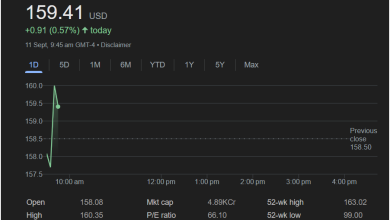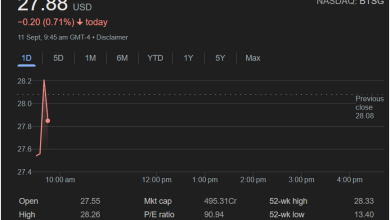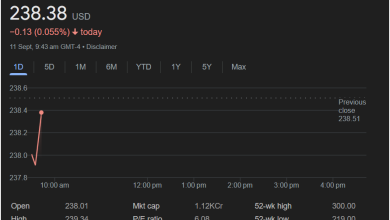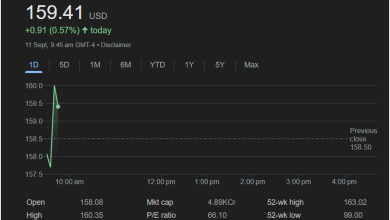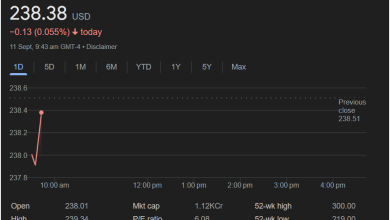A Snapshot of Amazon’s Trading Day: Volatility and Market Dynamics
Examining AMZN's Performance and Key Financial Indicators on a Specific Trading Session

Analysis of the Provided Amazon (AMZN) Stock Data:
The image displays a “Market Summary” for Amazon.com Inc (AMZN) for a specific trading day, September 5th, with a closing price of 232.33 USD. Let’s break down the information presented:
1. Stock Price and Daily Change:
-
Current Price: 232.33 USD
-
Daily Change: -3.35 USD
-
Percentage Change: -1.42%
-
Interpretation: On this particular day, Amazon’s stock experienced a decline. It closed down $3.35, representing a 1.42% drop from its previous closing price. This indicates a negative sentiment or selling pressure during the trading session.
2. Trading Session Details:
-
Date: Closed: 5 Sept, 8:00 pm GMT-4
-
After Hours: 232.09 -0.24 (0.10%)
-
Interpretation: The regular trading session closed at 8:00 pm GMT-4 on September 5th. Following regular hours, the stock continued to trade in the after-hours market, where it saw a further slight decrease of $0.24 (0.10%), closing at 232.09 USD. After-hours trading can sometimes be less liquid and more volatile, often reacting to late-breaking news or earnings announcements.
3. Intraday Performance (1D Chart):
The line graph visually represents the stock’s price movement throughout the day:
-
Morning Rally/Peak: The stock appears to have opened higher or rallied early in the day, reaching a peak around 10:00 am, possibly near or slightly above 235 USD.
-
Mid-Day Decline: From its morning peak, AMZN’s price steadily declined through the late morning and early afternoon, crossing below the 234 USD mark.
-
Afternoon Stabilization/Further Decline: The decline continued, albeit at a slower pace, into the late afternoon, dipping below 232 USD before the regular market close. The grey line extending into the evening shows the after-hours trading, continuing the slight downward trend.
-
Previous Close: The dashed grey line indicates the “Previous close” at 235.68 USD. This confirms that the stock traded below its previous day’s closing price for most of the depicted session, especially after the initial morning hours.
4. Key Financial Metrics and Ratios:
These figures provide a broader context of Amazon’s valuation and market position:
-
Open: 235.19 USD
-
High: 236.00 USD
-
Low: 231.93 USD
-
Interpretation:
-
The “Open” price was 235.19 USD, slightly below the previous close, suggesting a gap down or minimal movement at market open compared to the prior day’s close.
-
The “High” for the day was 236.00 USD, confirming the early morning rally almost touched the previous day’s close.
-
The “Low” for the day was 231.93 USD, indicating the extent of the day’s decline.
-
-
Mkt cap (Market Capitalization): 2.48L Cr (This notation likely means 2.48 Lakh Crores, which translates to 2.48 Trillion, assuming it’s a commonly used regional notation for large numbers. In standard US notation, it would be $2.48 Trillion.)
-
Interpretation: Market capitalization is the total value of a company’s outstanding shares. A market cap of approximately $2.48 trillion places Amazon among the largest publicly traded companies globally, reflecting its massive scale, influence, and investor confidence.
-
P/E ratio (Price-to-Earnings ratio): 35.45
-
Interpretation: The P/E ratio is a valuation metric that compares a company’s current share price to its per-share earnings. A P/E of 35.45 suggests that investors are willing to pay $35.45 for every $1 of Amazon’s annual earnings. This is generally considered a relatively high P/E ratio, often indicative of a growth stock where investors anticipate significant future earnings growth. It implies that Amazon’s stock price reflects expectations of strong future performance rather than just current profitability.
-
Div yield (Dividend Yield): –
-
Qtrly div amt (Quarterly Dividend Amount): –
-
Interpretation: The dashes indicate that Amazon does not currently pay a dividend to its shareholders. Many growth-oriented companies, especially in the technology sector, choose to reinvest their profits back into the business for expansion and innovation rather than distributing them as dividends.
-
52-wk high: 242.52
-
52-wk low: 161.38
-
Interpretation:
-
The “52-wk high” of 242.52 USD represents the highest price Amazon’s stock has traded at in the past year.
-
The “52-wk low” of 161.38 USD represents the lowest price it has traded at in the past year.
-
Comparing the current price (232.33 USD) to these ranges shows that Amazon is trading closer to its 52-week high than its 52-week low. This suggests a strong performance over the past year, despite the minor dip on this specific day. It implies that the stock has experienced significant appreciation, and the current price is still within a relatively high range historically for the past year.
-
5. Broader Market Context and Potential Influences (Open-Ended Discussion Points):
To expand this into a larger analysis, one would need to consider various external factors and Amazon-specific news that could have contributed to this specific day’s performance. Since the request is open-ended, here are areas to explore without drawing a definitive conclusion:
-
Sector Performance: How did the broader technology sector or the NASDAQ index perform on September 5th? If the entire sector was down, Amazon’s decline might be part of a larger trend. If the sector was up, Amazon’s specific decline would warrant closer examination.
-
Macroeconomic Data: What economic news was released on or around September 5th? Interest rate expectations, inflation reports, job numbers, or consumer confidence surveys can all influence investor sentiment towards growth stocks like Amazon.
-
Company-Specific News: Were there any announcements from Amazon that day? This could include product launches, strategic partnerships, executive changes, regulatory news, or analyst downgrades/upgrades that could directly impact its stock price.
-
Analyst Ratings: Did any financial analysts change their rating or price target for AMZN?
-
Trading Volume (Not provided, but crucial): High trading volume during a price decline can indicate strong conviction from sellers. Low volume might suggest a less significant move.
-
Technical Analysis: Experienced traders would look at technical indicators, support and resistance levels, and chart patterns to interpret the intraday price action and predict future movements. The consistent decline after the morning peak could signal a breakdown of a short-term support level.
-
Investor Sentiment: General market sentiment, fear of recession, geopolitical events, or shifts in investor preference (e.g., from growth to value stocks) can all play a role.
-
Competitive Landscape: News or performance of competitors (e.g., Walmart, Shopify, Microsoft in cloud computing) could indirectly affect Amazon’s stock.
-
Upcoming Events: Are there any major events for Amazon on the horizon (e.g., earnings report, Prime Day, investor day) that might have caused investors to adjust their positions in anticipation?
The data from September 5th provides a snapshot of a single trading day where Amazon.com Inc. experienced a moderate decline. While the daily movement is important, it’s crucial to understand that short-term fluctuations are common in the stock market. A single day’s performance, especially for a company of Amazon’s size and complexity, rarely tells the whole story. Instead, it serves as a data point within a much larger, ongoing narrative influenced by internal company performance, sector trends, macroeconomic forces, and evolving investor sentiment. To fully understand this day’s implications, one would need to integrate this data with broader market analysis and specific catalysts that may have been at play.
